List of oldest extant buildings facts for kids
This article is about some of the oldest buildings still standing today! These amazing structures have survived for thousands of years, showing us how people lived and built in ancient times. From homes to temples and tombs, these buildings tell incredible stories about human history.
Contents
What Makes a Building "Oldest"?
To be on this list, a structure needs to be a real building. This means it must:
- Be clearly recognizable as a building.
- Have walls that are at least 1.5 meters (about 5 feet) tall.
- Be mostly complete, or have most of its original walls still standing at that height.
- Have an enclosed space with at least one way to get inside.
This list doesn't include things like:
- Dolmens: These are ancient stone tombs, usually just a few big stones holding up a flat capstone. They were often covered with earth, but that covering has usually worn away.
- Cairns: These are just big piles of loose stones.
- Standing stone rings: Like Stonehenge, these don't count because they aren't enclosed and don't have roofs.
Also, remember that the dates for many of these super old buildings are estimates. Scientists use methods like radiocarbon dating to figure out how old they are.
Oldest Buildings by Age
Here are some of the world's oldest buildings that still meet our rules. While there are older human-made structures, like those at Göbekli Tepe, they are often monuments, not buildings in the way we've defined them. Many buildings on this list are made of bricks and still have their walls and roofs. You'll find many amazing old structures in the Orkney islands of Scotland, which are a World Heritage Site. There are also many huge buildings from ancient Egypt's "Age of the Pyramids."
| Building | Image | Country | Continent | First built | Use | Note |
|---|---|---|---|---|---|---|
| Göbekli Tepe |  |
Turkey | Asia | 9500–7500 BCE | Place of worship | This site in southern Turkey has two main periods of use. Experts believe it was a social or religious place. It's a huge structure, 300 meters wide and 15 meters tall. |
| Tower of Jericho |  |
West Bank, Palestine | Asia | 8000 BC | Tower | This stone tower is 8.5 meters (28 feet) tall. It has an inner staircase with twenty-two steps. |
| Çatalhöyük |  |
Turkey | Asia | 7500–5700 BCE | Settlement | A very large ancient village in southern Turkey. It was a "proto-city," meaning it was like an early city. |
| Mehrgarh |  |
Pakistan | Asia | 7000 BCE | Settlement | This ancient site is in Balochistan, Pakistan. It's located near the Bolan Pass, between the Indus River and modern cities like Quetta. |
| Aquae Calidae | 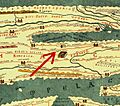 |
Bulgaria | Europe | 6000-5000 BCE | Ancient town | Found in the Bulgarian city of Burgas on the Black Sea coast. It was an ancient town in Thrace, also known as Therma. |
| Barnenez |  |
France | Europe | 4800 BC | Passage grave | Located in northern France and partly fixed up. It's 72 meters (236 feet) long, 25 meters (82 feet) wide, and over 8 meters (26 feet) high. |
| Tumulus of Bougon |  |
France | Europe | 4800 BC | Tumulus | This is a burial ground with many tombs of different ages. The oldest parts are called E and F0. |
| Saint-Michel tumulus |  |
France | Europe | 4500 BC | Tumulus | This tumulus is like an artificial hill. It's huge, with over 30,000 cubic meters (1,059,440 cubic feet) of material. |
| Anu ziggurat of Uruk |  |
Iraq | Asia | 4000–3800 BC | Ziggurat | A massive White Temple was built on top of this ziggurat. A Stone Temple was also found nearby. |
| Monte d'Accoddi |  |
Italy (Sardinia) | Europe | 4000–3650 BC | Possibly an open-air temple or step pyramid. | This structure is a trapezoidal platform on an artificial mound. New dating shows the first part was built between 4000–3650 BC. |
| La Hougue Bie | 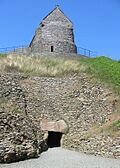 |
Jersey | Europe | 4000–3500 BC | Passage grave | This is an 18.6-meter (61-foot) long ancient tomb. It has a medieval chapel built above it and even World War II structures. |
| Knap of Howar |  |
United Kingdom (Scotland) | Europe | 3700 BC | House | This is the oldest preserved stone house in northwest Europe. |
| Ġgantija |  |
Malta | Europe | 3700 BC | Temple | These are two structures on the island of Gozo. The second one was built 400 years after the first. |
| Dolmen of Menga |  |
Spain | Europe | 3700 BC | Tomb | This is a huge stone burial mound, also known as a tumulus or long barrow. |
| West Kennet Long Barrow |  |
United Kingdom (England) | Europe | 3650 BC | Tomb | This tomb is located near famous ancient sites like Silbury Hill and the Avebury stone circle. |
| Listoghil | 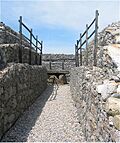 |
Ireland | Europe | 3550 BC | Passage Tomb | This tomb is at the center of many other passage tombs. It has a simple box-shaped room surrounded by a stone circle. |
| Stoney Littleton Long Barrow |  |
United Kingdom (England) | Europe | 3550 BC | Tomb | This ancient tomb has many burial rooms. It's part of a group of tombs found in the Severn-Cotswold area of England. |
| Sechin Bajo |  |
Peru | South America | 3500 BC | Plaza | This is the oldest known building in the Americas. |
| Dholavira |  |
India | Asia | 3500 BC | Settlement | A complex of ruins with different dates. It has brick water reservoirs, circular graves, and a well-planned town. |
| Midhowe Chambered Cairn | 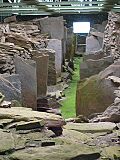 |
United Kingdom (Scotland) | Europe | 3500 BC | Tomb | A very well-preserved tomb on the island of Rousay. |
| Gavrinis passage tomb |  |
France | Europe | 3500 BC | Tomb | This tomb is on a small island in the Gulf of Morbihan. |
| Wayland's Smithy |  |
United Kingdom (England) | Europe | 3460 BC | Chamber tomb | This is a burial mound built on top of an even older burial chamber. |
| Unstan Chambered Cairn | 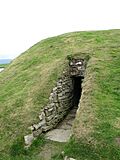 |
United Kingdom (Scotland) | Europe | 3450 BC | Tomb | When this tomb was dug up in 1884, ancient items were found inside. |
| Loughcrew |  |
Ireland | Europe | 3400 BC | Tomb | This site has ancient burial grounds dating back to around 3500 and 3300 BC. |
| Knowe of Yarso chambered cairn |  |
United Kingdom (Scotland) | Europe | 3350 BC | Tomb | This is one of several tombs on Rousay island. Many deer skeletons were found here when it was dug up in the 1930s. |
| Quanterness chambered cairn |  |
United Kingdom (Scotland) | Europe | 3250 BC | Tomb | The remains of 157 people were found inside this tomb when it was dug up in the 1970s. |
| Tarxien Temples | 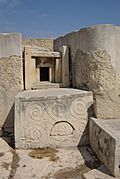 |
Malta | Europe | 3250 BC | Temples | These temples are part of the Megalithic Temples of Malta World Heritage Site. |
| Shahr-e Sukhteh |  |
Iran | Asia | 3200 BC | Settlement | This site gives us a lot of information about how complex societies started and connected with each other thousands of years ago. |
| Newgrange |  |
Ireland | Europe | 3200 BC | Burial | This ancient passage grave has been partly rebuilt around its original structure. |
| Knowth |  |
Ireland | Europe | c. 3200 BC | Passage grave | This is an ancient passage grave and part of the Brú na Bóinne World Heritage Site. |
| Dowth |  |
Ireland | Europe | between 3200 and 2900 BC | Tomb | The burial mound is about 85 meters (279 feet) wide and 15 meters (49 feet) high. |
| Skara Brae |  |
United Kingdom (Scotland) | Europe | 3180 BC | Settlement | This is the best-preserved ancient village in Northern Europe. |
| Tomb of the Eagles |  |
United Kingdom (Scotland) | Europe | 3150 BC | Tomb | This tomb was used for over 800 years. Many bird bones, especially from white-tailed sea eagles, were found here. |
| Tepe Sialk ziggurat | Iran | Asia | 3000 BC | Ziggurat | The oldest parts of Sialk date back to around 6000–5500 BC. This ziggurat was built around 3000 BC. | |
| Dolmen de Bagneux |  |
France | Europe | 3000 BC | Dolmen | This is the largest dolmen in France, and possibly the world. It's 23 meters (75 feet) long, with an inner room over 18 meters (59 feet) long and at least 3 meters (10 feet) high. |
| Grey Cairns of Camster |  |
United Kingdom (Scotland) | Europe | 3000 BC or older | Tomb | Located near Upper Camster in Scotland. |
| Hulbjerg Jættestue |  |
Denmark | Europe | 3000 BC | Passage grave | This tomb is hidden by a round mound on the island of Langeland. A skull found here showed signs of the world's earliest dental work! |
| Dolmens of North Caucasus |  |
Russia | Europe | 3000 BC | Tomb | There are many tombs in the North Caucasus region. Some might be from the ancient Maikop culture. |
| Taversoe Tuick chambered cairn |  |
United Kingdom (Scotland) | Europe | 3000 BC | Tomb | This tomb is unusual because it has both an upper and a lower chamber. |
| Holm of Papa chambered cairn |  |
United Kingdom (Scotland) | Europe | 3000 BC | Tomb | The main room of this tomb is over 20 meters (66 feet) long. |
| Barpa Langass |  |
United Kingdom (Scotland) | Europe | 3000 BC | Tomb | This is the best-preserved chambered cairn in the Hebrides islands. |
| Cuween Hill Chambered Cairn |  |
United Kingdom (Scotland) | Europe | 3000 BC | Tomb | When this tomb was dug up in 1901, bones of humans, dogs, and oxen were found inside. |
| Quoyness cairn |  |
United Kingdom (Scotland) | Europe | 2900 BC | Tomb | This cairn on the island of Sanday is surrounded by a curve of Bronze Age mounds. |
| Maeshowe | 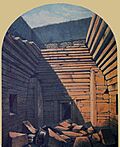 |
United Kingdom (Scotland) | Europe | 2800 BC | Tomb | The entrance passage is 36 feet (11 meters) long and leads to a central room about 15 feet (4.6 meters) on each side. |
| Shunet El Zebib |  |
Egypt | Africa | 2700 BC | Mortuary temple | This was built as a special enclosure for funerals, where the dead king was honored. |
| Pyramid of Djoser |  |
Egypt | Africa | 2667–2648 BC | Burial | This is the earliest large building made of cut stone. |
| Harappa |  |
Pakistan (Then India) | Asia | 2600 BC | Settlement | A fortified city from the Bronze Age with houses made of clay. It was part of the Indus Valley civilization. |
| Mohenjo Daro |  |
Pakistan (Then India) | Asia | 2600 BC | Settlement | An ancient site near Larkana. It's one of the world's earliest settlements with brick houses, public baths, and covered drains. |
| Caral | Peru | South America | 2600 BC | Pyramid | This pyramid was once thought to be the oldest building in South America. | |
| Pyramid of Meidum |  |
Egypt | Africa | c. 2580 BC | Tomb | This pyramid was finished by Pharaoh Sneferu during the Fourth Dynasty of Egypt. |
| Bent Pyramid |  |
Egypt | Africa | c. 2580 BC | Tomb | This is another pyramid finished by Pharaoh Sneferu. |
| Red Pyramid |  |
Egypt | Africa | c. 2580 BC | Tomb | This is the third large pyramid finished by Sneferu. |
| Great Pyramid of Giza |  |
Egypt | Africa | 2560 BC | Tomb | This huge pyramid was built for Pharaoh Khufu. It was the world's tallest human-made structure for over 3,800 years! |
| Megalithic Monuments of Alcalar |  |
Portugal | Europe | Between 3000 and 2000 BC | Tomb | This is a group of burial tombs that form an ancient cemetery. |
| Capel Garmon |  |
United Kingdom (Wales) | Europe | c. 2500 BC | Tomb | A burial chamber from around 2500 BC. It belongs to the Severn-Cotswold Group of tombs. |
| Pyramid of Khafre |  |
Egypt | Africa | c. 2500 BC | Tomb | This is one of the famous Pyramids of Giza. |
| Pyramid of Menkaure |  |
Egypt | Africa | c. 2500 BC | Tomb | Menkaure was likely the pharaoh who came after Khafre. |
| Pyramid of Userkaf |  |
Egypt | Africa | c. 2480 BC | Tomb | This pyramid is located close to the Pyramid of Djoser. |
| Pyramid of Sahure |  |
Egypt | Africa | c. 2480 BC | Tomb | Built for Pharaoh Sahure. |
| Pyramid of Neferirkare Kakai |  |
Egypt | Africa | c. 2460 BC | Tomb | Built for Pharaoh Neferirkare Kakai. |
| Pyramid of Neferefre |  |
Egypt | Africa | c. 2455 BC | Tomb | This pyramid was never fully finished, but it does contain a tomb. |
| Pyramid of Nyuserre |  |
Egypt | Africa | c. 2425 BC | Tomb | |
| Royal Palace of Ebla |  |
Syria | Asia | 2400–2300 BC | Palace | |
| Pyramid of Djedkare-Isesi |  |
Egypt | Africa | c. 2370 BC | Tomb | |
| Pyramid of Unas |  |
Egypt | Africa | c. 2340 BC | Tomb | |
| Pyramid of Teti |  |
Egypt | Africa | c. 2330 BC | Tomb | |
| Labbacallee |  |
Ireland | Europe | c. 2300 BC | Tomb | This is the largest wedge tomb in Ireland. |
| Shimao | China (Shaanxi) | Asia | 2300–2000 BC | Settlement | A fortified ancient site with a huge stepped pyramid that is 70 meters (230 feet) tall. | |
| Pyramid of Merenre |  |
Egypt | Africa | c. 2275 BC | Tomb | Built for Pharaoh Merenre Nemtyemsaf I but not finished. |
| Pyramid of Pepi II |  |
Egypt | Africa | c. 2180 BC | Tomb | |
| Crantit cairn | United Kingdom (Scotland) | Europe | 2130 BC | Tomb | This tomb was found in 1998 near Kirkwall. | |
| Ziggurat of Ur |  |
Iraq | Asia | 2100 BC | Temple | The Great Ziggurat of Ur was a temple built to honor the goddess Nanna. It was partly rebuilt in the 1980s. |
| Dolmen de Viera | 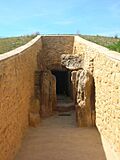 |
Spain | Europe | 2000 BC | Tomb | The Dolmen de Viera is a type of ancient stone tomb with a single chamber. |
| Dolmen of Cava dei Servi |  |
Italy (Sicily) | Europe | 2000 BC | Tomb | This dolmen is a semi-oval monument made of four stone slabs fixed into the ground. |
| Rubha an Dùnain passage grave |  |
United Kingdom (Scotland) | Europe | 2000 BC or older | Tomb | |
| Corrimony chambered cairn |  |
United Kingdom (Scotland) | Europe | 2000 BC or older | Tomb | This is an ancient passage grave surrounded by a circle of 11 standing stones. |
| Bryn Celli Ddu |  |
United Kingdom (Wales) | Europe | 2000 BC | Tomb | Located on the island of Anglesey. |
| Balnuaran of Clava |  |
United Kingdom (Scotland) | Europe | 2000 BC | Tomb | The largest of these three cairns was partly rebuilt in the 1800s. |
| Vinquoy chambered cairn, Eday |  |
United Kingdom (Scotland) | Europe | 2000 BC | Tomb | |
| Pyramid of Amenemhat I |  |
Egypt | Africa | c. 1960 BC | Tomb | |
| Karnak |  |
Egypt | Africa | 1971–1926 BC | Temple | This is actually a huge complex of temples. |
| Pyramid of Senusret I |  |
Egypt | Africa | c. 1920 BC | Tomb | |
| Pyramid of Senusret II |  |
Egypt | Africa | c. 1875 BC | Tomb | |
| Knossos |  |
Greece | Europe | 1850–1750 BC | Palace | This ancient Minoan palace was built on an even older site. |
| Pyramid of Senusret III |  |
Egypt | Africa | c. 1835 BC | Tomb | Built for Pharaoh Senusret III. |
| Black Pyramid |  |
Egypt | Africa | c. 1820 BC | Tomb | Built for Pharaoh Amenemhat III. It has some problems with its structure. |
| Hawara |  |
Egypt | Africa | c. 1810 BC | Tomb | Also built for Amenemhat III. |
| Pyramid of Khendjer |  |
Egypt | Africa | c. 1760 BC | Tomb | Built for Pharaoh Khendjer. |
| Daorson |  |
Bosnia and Herzegovina | Europe | 17–16th century BC | City and citadel | This was an ancient settlement and capital city of the Daorsi tribe. |
| Mortuary Temple of Hatshepsut |  |
Egypt | Africa | 15th century BC | Temple | |
| Nuraghe Santu Antine |  |
Italy (Sardinia) | Europe | 1600 BC | Possibly a fort | This is the second tallest ancient stone tower found in Sardinia, and it's still standing tall. |
| Sinauli |  |
India | Asia | 1800 BC | Settlement | This excavation site in India has major findings from around 2000 - 1800 BCE. |
| Adichanallur |  |
India | Asia | 1500 BC | Settlement | In 2004, many skeletons were found buried in clay pots here. Some pots had ancient writing. |
| Su Nuraxi di Barumini |  |
Italy (Sardinia) | Europe | 1500 BC | Possibly a fort or a palace | This ancient palace has a huge central tower, which was originally almost 20 meters (66 feet) high. |
| Luxor Temple |  |
Egypt | Africa | c.1400 BC | Temple | This is actually a complex of temples. |
| Nuraghe La Prisciona | Italy (Sardinia) | Europe | 1400 BC | Possibly a fort | This monument has a central tower and two side towers. The central room is over 6 meters (20 feet) high. | |
| The King's Grave |  |
Sweden | Europe | 1400 BC | Tomb | Near Kivik are the remains of a very grand double burial from the Nordic Bronze Age. |
| The Ziggurat of Dur-Kurigalzu | 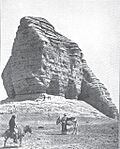 |
Iraq | Asia | 14th century BC | Probably religious rituals | Built for the Kassite King Kurigalzu I. |
| Treasury of Atreus |  |
Greece | Europe | 1250 BC | Tomb | This tomb had the tallest and widest dome in the world for over a thousand years. |
| Chogha Zanbil |  |
Iran | Asia | 1250 BC | Temple | This is one of the few ancient ziggurats still standing outside of Mesopotamia. |
| Mortuary Temple of Seti I |  |
Egypt | Africa | 13th century BC | Temple | |
| Ramesseum |  |
Egypt | Africa | 13th century BC | Temple | This was the funeral temple of Pharaoh Ramses II. |
| Naveta d'Es Tudons |  |
Spain | Europe | 1200–750 BC | Ossuary | This is the most famous ancient stone tomb on the island of Menorca. |
| Mortuary Temple of Ramesses III |  |
Egypt | Africa | 1186–1155 BC | Temple | |
| Dún Aonghasa |  |
Ireland | Europe | 1100 BC | Fort | This ancient fort is considered one of the most amazing prehistoric monuments in Western Europe. |
| Cuicuilco Circular Pyramid |  |
Mexico | North America | 800–600 BC | Ceremonial center | This is one of the oldest standing structures from the Mesoamerican cultures. |
| Van Fortress |  |
Turkey | Asia | 750 BC | Fortress | A massive stone fortress built by the ancient Urartu people, overlooking Tushpa. |
| Necropolises of Cerveteri and Tarquinia |  |
Italy | Europe | 700 BC | Tombs | These ancient Etruscan cemeteries have thousands of tombs, some laid out like a city. |
| Temple of Cyrene |  |
Libya | Africa | c. 630 BC | Temple | This temple was destroyed and rebuilt around 115 AD. It was also damaged in the 4th century AD. |
| Keezhadi excavation site |  |
India | Asia | 580 BC | Settlement | This excavation site is from the Sangam period. It's being dug up by the Archaeological Survey of India. |
| Temple of Hera |  |
Italy | Europe | 550 BC | Temple | This temple is part of a complex of three large temples built in the Doric style. |
| Tomb of Cyrus |  |
Iran | Asia | 530 BC | Tomb | This is the tomb of Cyrus the Great, located in Pasargadae. |
| Persepolis |  |
Iran | Asia | 522 BC | Ceremonial capital | This was the ceremonial capital city of the ancient Achaemenid Empire. |
| Yeha Temple |  |
Ethiopia | Africa | 500 BC | Temple | This is a temple dedicated to the sun and moon. |
| Parthenon |  |
Greece | Europe | 432–447 BC | Temple | This famous temple is located on the Acropolis of Athens. |
| Tomb of Seuthes III |  |
Bulgaria | Europe | 450–400 BC | Tomb | This tomb was originally a temple. Later, the Thracian king Seuthes III was buried inside. |
| Thracian Tomb of Kazanlak |  |
Bulgaria | Europe | 300–400 BC | Tomb | This tomb is near Seutopolis, the capital city of the Thracian kingdom. It's one of the most detailed tombs in the area. |
| Sanchi Stupa |  |
India | Asia | 300 BC | Buddhist temple | Located in the village of Sanchi. |
| Thracian Tomb of Sveshtari |  |
Bulgaria | Europe | 300–280 BC | Tomb | This tomb was found in 1982. Its unique decorations include half-human, half-plant figures and painted murals. |
| Dhamek Stupa |  |
India | Asia | 249 BC rebuilt c. 500 AD | Buddhist Temple | Located in Sarnath, Varanasi. |
| Mausoleum of the First Qin Emperor | 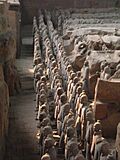 |
China | Asia | Began construction 246 BC, finished 208 BC | Tomb | Also known as the Terracotta Army, this is one of the largest tombs ever built. It holds a huge stone army and the resting place of Qin Shi Huang. |
| Ruwanwelisaya |  |
Sri Lanka | Asia | 140 BC | Stupa | Located in Anuradhapura, Sri Lanka. |
| Broch of Mousa |  |
United Kingdom (Scotland) | Europe | 100 BC | Broch | Located in Shetland, this is one of the best-preserved ancient buildings in Europe. |
| Dun Carloway |  |
United Kingdom (Scotland) | Europe | 100 BC | Broch | Built in the first century BC. |
| Masada |  |
Israel | Asia | 37 BC | Fortress | Herod the Great built two palaces and fortified Masada between 37 and 31 BCE. |
| Maison Carrée |  |
France | Europe | 4–7 AD | Temple | One of the best-preserved Roman temples, located in Nîmes. |
| Lei Cheng Uk Han Tomb Museum |  |
China (Hong Kong) | Asia | 25 AD | Tomb | |
| Temple of Garni |  |
Armenia | Asia | c. 77 AD | Temple | |
| Colosseum |  |
Italy | Europe | 70–80 AD | Amphitheatre |
Oldest Buildings by Continent
Here are some of the oldest known buildings still standing on each major continent.
| Building | Image | Country | Continent | First built | Use | Notes |
|---|---|---|---|---|---|---|
| Göbekli Tepe |  |
Turkey | Asia | 9500 – 7500 BC | Unknown, likely temple | Located in southern Turkey. It's believed to have been a social or ritual place. The structure is 300 meters (984 feet) wide and 15 meters (49 feet) high. |
| Durankulak (archaeological site) |  |
Bulgaria | Europe | 5500—4100 BC | Settlement | This archaeological site in Bulgaria has settlements from different ancient cultures. It shows how people lived and built thousands of years ago. |
| Solnitsata |  |
Bulgaria | Europe | 5500 BC | Settlement | Thought to be Europe's oldest town. It was a fortified stone settlement and salt production site. A lot of ancient gold was found nearby. |
| Shunet El Zebib |  |
Egypt | Africa | 2700 BC | Mortuary temple | Built as a special enclosure for funerals, where the dead king was honored. |
| Los Naranjos |  |
Honduras | North America | 2000 BC | Temples | These are the oldest standing buildings in Honduras, built by the ancestors of the Lenca people. |
| Nan Madol |  |
Federated States of Micronesia | Oceania | 700s AD | City | This city was built by the Pohnpeians on human-made islands. It has the oldest known buildings in Oceania. |
| Cape Adare huts | Ross Dependency | Antarctica | 1899 AD | Explorers' huts | These wooden buildings were constructed by Carsten Borchgrevink in Antarctica. |
Oldest Buildings by Country
Here are some of the oldest buildings in their specific countries.
| Building | Image | Country | Continent | First Built | Use | Notes |
|---|---|---|---|---|---|---|
| Göbeklitepe |  |
Turkey | Asia | 9500-7500 BC | Unknown/likely temple | This is the oldest temple and oldest structure in the world. |
| Durankulak |  |
Bulgaria | Europe | 5500—4100 BC | Settlement | The Durankulak Archaeological Complex includes three sites. It shows settlements from various ancient cultures. |
| Solnitsata |  |
Bulgaria | Europe | 5500 BC | Settlement | Believed to be Europe's oldest town. It was a fortified stone settlement for salt production. Ancient gold was found nearby. |
| L'Anse aux Meadows |  |
Canada | North America | c. 1000 AD | Settlement | Located in Newfoundland, this Norse settlement shows that Vikings were in North America before Columbus. |
| Shimao | China | Asia | 2300–2000 BC | Settlement | A fortified ancient site with a large stepped pyramid that is 70 meters (230 feet) tall. | |
| St. George's Basilica, Prague |  |
Czech Republic | Europe | c. 920 AD | Church | Located inside Prague Castle. It now holds a collection of 19th-century art. |
| Hulbjerg Jættestue |  |
Denmark | Europe | 3000 BC | Passage grave | This tomb is hidden by a round mound. A skull found here showed signs of the world's earliest dental work. |
| West Kennet Long Barrow |  |
United Kingdom (England) | Europe | 3650 BC | Tomb | Located near Silbury Hill and the Avebury stone circle. |
| Yeha Temple |  |
Ethiopia | Africa | 500 BC | Temple | This is the oldest standing structure in Ethiopia. |
| Barnenez |  |
France | Europe | 4850 BC | Passage grave | Located in northern France and partly restored. It's 72 meters (236 feet) long, 25 meters (82 feet) wide, and over 8 meters (26 feet) high. It's the oldest known building in Eurasia. |
| Porta Nigra |  |
Germany | Europe | 180 AD | Roman city gate | This is the largest Roman city gate north of the Alps. |
| Knossos |  |
Greece | Europe | 2000–1300 BC | Palace | This ancient Minoan palace was built on an even older site. |
| Dholavira |  |
India | Asia | 3500 BC | Reservoir | A planned ancient town with reservoirs, pottery, and seals. |
| Chogha Zanbil |  |
Iran | Asia | 1250 BC | Temple | One of the few ancient ziggurats still standing outside of Mesopotamia. |
| The Ziggurat of Dur-Kurigalzu | 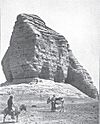 |
Iraq | Asia | 14th century BC | Probably religious rituals | Built by the Kassite King Kurigalzu I. |
| Newgrange |  |
Ireland | Europe | 3200–2900 BC | Burial | This ancient passage grave has been partly rebuilt around its original structure. |
| Monte d'Accoddi |  |
Italy (Sardinia) | Europe | 4000–3600 BC | Possibly an open-air temple, a ziggurat, or a step pyramid. | A trapezoidal platform on an artificial mound, reached by a sloped pathway. |
| Ġgantija |  |
Malta | Europe | 3700 BC | Temple | Two structures on the island of Gozo. The second was built 400 years after the oldest. |
| Cuicuilco Circular Pyramid |  |
Mexico | North America | 800–600 BC | Ceremonial center | One of the oldest standing structures from the Mesoamerican cultures. |
| Hunebed (Dolmen) |  |
Netherlands | Europe | 4000–3000 BC | Burial | These ancient stone structures are believed to be prehistoric burial chambers. |
| Mission House |  |
New Zealand | 1822 AD | Religious | Built by Māori people and missionary carpenters. | |
| Mehrgarh |  |
Pakistan(Then India) | Asia | c. 2600 BC | Mud brick storage structures | A complex of ruins with different dates near Bolan Pass. |
| Sechin Bajo |  |
Peru | South America | 3500 BC | Plaza | This is the oldest known building in the Americas. |
| Dolmens of North Caucasus |  |
Russia | Europe | 3000 BC | Tomb | There are many tombs in the North Caucasus region. Some might be from the ancient Maikop culture. |
| Knap of Howar |  |
United Kingdom (Scotland) | Europe | 3700 BC | House | This is the oldest preserved stone house in northwest Europe. |
| Naveta d'Es Tudons |  |
Spain | Europe | 1200–750 BC | Ossuary | This is the most famous ancient stone tomb on the island of Menorca. |
| The King's Grave |  |
Sweden | Europe | 1000 BC | Tomb | Near Kivik are the remains of a very grand double burial from the Nordic Bronze Age. |
| Hattusa |  |
Turkey | Asia | c. 1600 BC | Ramparts and ruined buildings | This was the capital city of the Hittite Empire in the late Bronze Age. |
| Saint Sophia Cathedral, Kyiv |  |
Ukraine | Europe | 1037 AD | Cathedral | This is an Orthodox cathedral that has been partly rebuilt. |
| Ancestral Puebloan communities |  |
United States | North America | 750 AD | Villages | Pueblo construction began in 750 AD and continues today. These buildings have been in the United States since 1848. |
| Bryn Celli Ddu |  |
United Kingdom (Wales) | Europe | 2000 BC | Tomb | Located on the island of Anglesey. |
| Great Zimbabwe |  |
Zimbabwe | Africa | 1000 AD | Palace | This was the capital city of a medieval kingdom. |
Oldest Buildings by Type
Here are some of the oldest buildings based on what they were used for, their structure, or what they were made of.
| Building | Image | Location | First built | Use | Notes |
|---|---|---|---|---|---|
| Göbekli Tepe |  |
Turkey | 9500–7500 BC | Unknown, likely temple | Located in southern Turkey. It's believed to have been a social or ritual place. The structure is 300 meters (984 feet) wide and 15 meters (49 feet) high. |
| Mehrgarh |  |
Pakistan (Then India) | 7000 BC | Settlement | An ancient site in Balochistan, Pakistan. It's located near the Bolan Pass. |
| Durankulak (archaeological site) |  |
Bulgarian | 4800–4100 BC | Settlement | The earliest stone architecture in continental Europe was found here in Bulgaria. |
| Pyramid of Djoser |  |
Saqqara, Egypt | 2667–2648 BC | Tomb | This is the oldest large building made of cut stone. |
| Luxor Temple |  |
Luxor, Egypt | 1400 BC | Religious | This is the oldest standing building that is still partly in use. There's an active mosque inside the main structure. |
| Sanchi Stupa |  |
India | 300 BC | Buddhist temple | This is the oldest standing Buddhist temple. |
| Temple of Concordia |  |
Italy | 440 BC | Temple | This is the oldest fully preserved temple from ancient times. |
| Mundeshwari Temple |  |
Bihar, India | 105–320 AD | Hindu Temple | This might be the oldest Hindu temple that hasn't been rebuilt. Inscriptions from 635 CE were found here. |
| Pantheon, Rome |  |
Italy | 125 AD | Religious | This is the oldest standing building that is still used regularly. |
| Aula Palatina |  |
Germany | 306 AD | Palace basilica | This building has the largest standing hall from ancient times. |
| Jokhang |  |
Lhasa, Tibet, China | c. 639 AD | Buddhist temple | This might be the world's oldest building made with a timber frame. |
| Hōryū-ji |  |
Nara, Japan | 670 AD | Buddhist Temple | This is the oldest wooden building still standing. |
| Nanchan Temple | 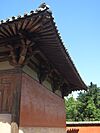 |
Wutai, China | 782 AD | Buddhist Temple | Its Great Buddha Hall is currently China's oldest standing timber building. |
| Greensted Church | 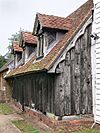 |
United Kingdom (England) | c. 1053 AD | Church | This might be the oldest standing wooden church in the world, and the oldest wooden building in Europe. |
| Roykstovan in Kirkjubø |  |
Faroe Islands | No clear date, middle of 11th century AD | Farmhouse | This might be the oldest wooden building in the world that has been lived in continuously. |
| Ditherington Flax Mill |  |
United Kingdom (England, Shrewsbury) | 1797 AD | Industrial | This is the oldest iron-framed building in the world. |
| Manhattan Building |  |
Chicago, United States | 1888 AD | Skyscraper | This is the oldest skyscraper still standing. |
See also
Lists
- List of oldest buildings in Scotland
- List of oldest buildings in the Americas
- List of oldest buildings in the United Kingdom
- List of oldest church buildings
- List of oldest continuously inhabited cities
- List of oldest synagogues
- List of the oldest buildings in the United States
- List of the oldest mosques
Sites
- Los Millares, an ancient site in Spain with both ruins and rebuilt structures.
- Antequera Dolmens Site, in Spain, a group of three important ancient monuments.

